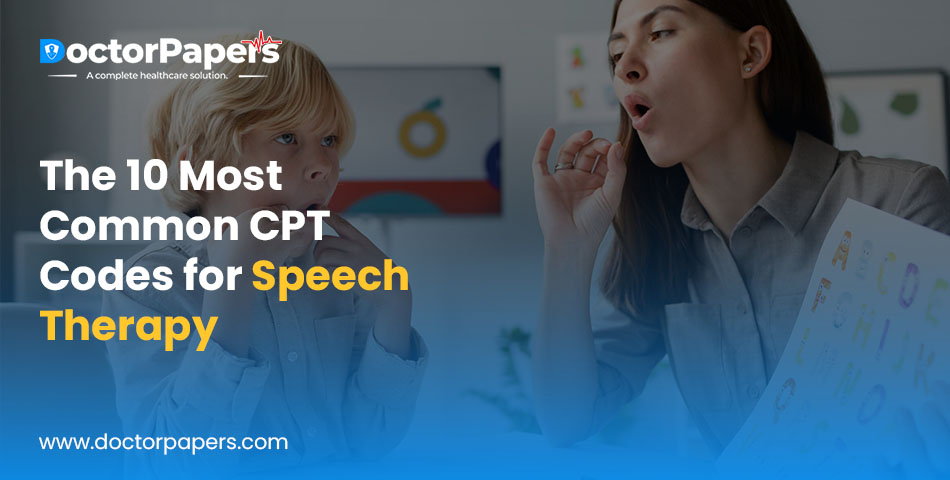The 10 Most Common CPT Codes for Speech Therapy

Medical billing codes can be overwhelming — there are numerous codes to select from, and many of them are closely related. However, mastering these procedure codes is essential for operating a successful practice. Picking the correct CPT code for a claim guarantees legitimate reimbursement for your administrations and limits the risk of costly and tedious rejections requiring resubmission. In this Article Why do CPT Codes Matter in Speech Therapy? Top 10 Common CPT Codes for Speech Therapy 92526 — Treatment of Swallowing Dysfunction and Oral Function for Feeding 92610 — Evaluation of Oral and Pharyngeal Swallowing Function 92521 — Evaluation of Speech Fluency (e.g., Stuttering, Cluttering) 92507 — Treatment of Speech, Language, Voice, Communication, and Auditory Processing Disorders 92605 — Evaluation for Non-Speech-Generating Augmentative and Alternative Communication Device 92609 — Therapeutic Services for the Use of Speech-Generating Devices 92606 — Therapeutic Services for Non-Speech-Generating AAC Devices 92523 — Evaluation of Speech Sound Production and Language Comprehension/Expression 31579 — Laryngoscopy with Stroboscopy (Flexible or Rigid Telescopic) Conclusion Why do CPT Codes Matter in Speech Therapy? These normalized codes empower clear correspondence between medical services providers, claim denials, and administrative bodies, decreasing the gamble of blunders and guaranteeing disavowals and likely reviews. By utilizing the correct CPT codes, language teachers can keep up with consistency with industry norms, smooth out their training with the board, and, at last, guarantee that they are genuinely made up for their work, all while giving continuous consideration to their patients. The Basics: A Guide to Understanding ICD-and HCPCS Codes for Speech Therapy Top 10 Common CPT Codes for Speech Therapy Understanding the most often utilized CPT codes in language training requires precise charging and documentation. Here is a rundown of the leading ten codes, alongside a short outline of their applications. While your medical biller should have top-to-bottom information on these codes, this guide offers a helpful reference. 92526 — Treatment of Swallowing Dysfunction and Oral Function for Feeding Use this code when addressing swallowing issues or difficulties with oral function related to feeding. Proper documentation should include a detailed oral mechanism exam, current dietary restrictions, and an assessment of how nutrition is maintained. Additionally, it’s essential to report the phases of swallowing (oral, pharyngeal, esophageal) and any compensation strategies being used. 92610 — Evaluation of Oral and Pharyngeal Swallowing Function This code evaluates a patient’s swallowing and feeding abilities. It may involve assessments of swallowing with different textures, a functional evaluation of muscles and structures, and observation of compensatory strategies. This also includes evaluating facial muscles, tongue, jaw, and other relevant areas. 92521 — Evaluation of Speech Fluency (e.g., Stuttering, Cluttering) When using this code, ensure that the evaluation includes quantitative and qualitative measurements of the patient’s fluency level, such as syllables per minute (SPM). You should also document the severity, frequency, and secondary characteristics like self-awareness or perception of dysfluency. 92507 — Treatment of Speech, Language, Voice, Communication, and Auditory Processing Disorders This code is used for therapeutic services related to auditory rehabilitation, voice prosthetics, and communication impairments. It’s a broad code that covers various treatment interventions, making it essential to document the specific disorder being addressed. 92524 — Behavioral and Qualitative Analysis of Voice and Resonance This code analyzes a patient’s voice and resonance using behavioral and qualitative methods. The evaluation should include perceptual ratings of pitch, loudness, and quality and the patient’s awareness of vocal issues. Note that this does not cover instrumental assessments. 92605 — Evaluation for Non-Speech-Generating Augmentative and Alternative Communication Device When a patient requires a non-speech-generating AAC device, this code is used for the initial evaluation (first hour). Follow-up evaluations that extend beyond an hour should be billed with code 92618 for additional 30-minute increments. The review should assess the patient’s communication skills, partners, demands, and motor/sensory abilities. 92609 — Therapeutic Services for the Use of Speech-Generating Devices Use this code for in-person therapeutic services that involve adapting a speech-generating device and training the patient to use it effectively. This code is essential when working with devices that help patients communicate verbally. 92606 — Therapeutic Services for Non-Speech-Generating AAC Devices Once a non-speech-generating AAC device is set up for a patient, this code is used for therapy sessions that focus on modifying, programming, and ensuring the device is used correctly for communication. Once the device is properly programmed, ongoing speech and language therapy should be billed under 92507. 92523 — Evaluation of Speech Sound Production and Language Comprehension/Expression This code evaluates speech sound production (articulation, phonology, apraxia, dysarthria) and includes an assessment of language comprehension and expression. When appropriate, document the patient’s speech in intelligibility using qualitative and quantitative measures and comparing them with developmental norms. 31579 — Laryngoscopy with Stroboscopy (Flexible or Rigid Telescopic) Code 31579 is used when a laryngoscope is inserted during an evaluation, which must adhere to the ASHA Code of Ethics and guidelines for laryngeal video endoscopy/stroboscopy. It’s important to note that this code should not be used for an evaluation—consider using code 92610 if that’s more appropriate. This list will help you use the correct codes and provide the necessary documentation when submitting claims. Accurate coding is critical to successful billing and reimbursement in speech therapy. Understanding Unlisted CPT Codes: A Coding Compliance Guide Conclusion Understanding and accurately using CPT codes in speech therapy is essential for ensuring proper documentation and reimbursement for services provided. These ten CPT codes represent some of the field’s most common procedures and evaluations. Speech therapists must stay informed about coding practices to avoid billing errors and ensure patients receive the necessary care.

